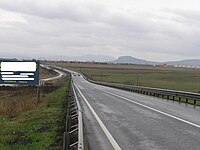Europastraße 68
| Europastraße 68 | |

|
|
| map | |
| Basic data | |
| Start of the street: |
Szeged ( 46 ° 18 ′ N , 20 ° 3 ′ E ) |
| End of street: |
Brașov ( 45 ° 40 ′ N , 25 ° 35 ′ E ) |
| Overall length: | 499 km |
|
States : |
|
| The E 68 at Orăştie | |
The Europastraße 68 (short: E 68 ) is part of the international road network. The European road running from west to east is 499 kilometers long and leads from Szeged in Hungary to Brașov in Romania . Here the road runs partly on the same route as the national road 7 ( Bucharest - Nădlac ).
The road goes through the following places: Szeged - Makó - Nagylak-Nădlac - Arad - Deva - Orăştie - Sebeş - Sibiu - Făgăraş - Braşov .
In Romania, the road leads Arad to Vinţu de Jos about 150 kilometers along the river Mures ( Mures ), then to the south of the Transylvanian Basin partially along the Olt ( Alt ).
meaning
The European route 68 is one of the busiest interurban roads in Romania. Since the beginning of the Yugoslav wars in the early 1990s, the transit routes through Serbia have been closed and all transit traffic from Turkey to Central and Northern Europe shifted to European route 68. However, this was not planned for such a traffic volume, and especially the route between Sibiu where the European route 81 coming from the south joins, and Szeged developed into a traffic hell. From the time of communism there were no bypasses, and the course of the road went right through the sometimes elongated street villages . In the villages this was also the main street, which is why agricultural vehicles and horse-drawn carriages also had to use this traffic area. Numerous accidents, some of them serious, were the result. Extreme accident accumulation points were the village of Apoldu de Sus / Großpold, the city of Sebeş / Mühlbach, the narrow through-roads in the Miereschtal and the route between Arad and Nădlac. At the Nagylak-Nădlac border crossing, there were frequent traffic jams for miles. In Hungary, the towns of Nagylak , Apátfalva , Makó and Kiszombor were particularly affected by the traffic avalanche . In the first years after the end of communism, all traffic also went through the cities of Sibiu, Orăştie, Deva and Arad, and in Hungary through the city center of Szeged.
The first relief was created at the end of the 1990s by building a bypass ( Roman Centură ) around the city of Arad, while the large overland routes were partially expanded to four lanes. After the end of the Yugoslav wars, the transit traffic from Turkey shifted very timidly back to the Autoput by Serbia. Meanwhile, the volume of traffic in Romania had increased so much that the traffic situation was not eased. When Hungary joined the EU in 2004, waiting times at the border were even tightened, as it now represented an EU external border. A noticeable relief for the affected places only came with the gradual construction of a motorway, both in Hungary and in Romania. In Hungary, the Autópálya M43 was used to bypass the city of Szeged. At the beginning of July 2015, the remaining section of the Hungarian M43 between Nagylak and Makó and the new motorway border crossing between Romania and Hungary were opened, so that the Romanian motorway network is connected to the European motorway network for the first time. The A1 Autostrada has now been completed in Romania from Nădlac to shortly after Lugoj near Traian Vuia and from Deva to Sibiu. The motorway sections between Lugoj and Deva should be completed in 2017 and 2018.
Romania's accession to the EU in 2007 reduced traffic jams at the Nagylak-Nădlac border. But since Romania is not yet a member of the Schengen Agreement , there are still personal controls there. In order to curb child trafficking in particular , all vehicles coming from Romania with minors on board are checked. The transport of goods is also checked on a random basis, which is why long traffic jams continue to occur during priority actions. Due to the horse meat scandal in Europe in 2013 , these controls were intensified again, especially in the case of live animal transports. After joining the EU, a law was passed in Romania that forbids horse-drawn carriages to drive on national roads. This reduced the traffic jams and accidents in the villages, especially since many carriages were also on the move at night and without lights, but many small farmers no longer have the opportunity to bring their products to the market in the cities.
In Romania, the A1 Autostrada is currently being built, and parts of it have already been completed. In 2010 the Sibiu motorway bypass was opened to traffic and at the end of 2013 the section between Deva and Sebeş, as well as a large part of the section between Sebeş and Sibiu. This section was completed at the end of 2014, as was the section between Pecica and Nădlac. This significantly relieved the European route 68. The completion of the A1 motorway on the entire route between Sibiu and Nădlac is expected in 2018.
In 2013, the Danube Bridge New Europe was opened between Vidin and Calafat , which is why part of the transit traffic from Turkey and Bulgaria now takes this route and does not return to European route 68 until Arad.
photos
history
Before 1992, in the former European road network, the E68 ran in Norway , Bergen - Oslo , via Nesttun-Norheimsund-Granby-Voss-Gudvangen- (ferry) -Lærdal-Hønefoss-Oslo. Today this is the E16 , with some newer roads.






